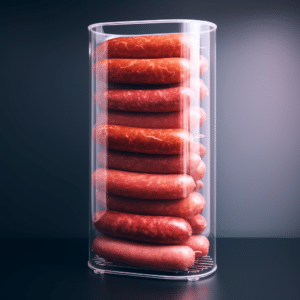
Safe Sausage Storage: Guidelines, Spoilage Signs and Risks
Sausage Storage Guidelines During their lifetime, animals inhibit numerous microorganisms which do not die after slaughtering the animals. Sausage meat spoils quickly due to those microorganisms, especially bacteria. When stored at room temperature, the bacteria multiply faster and cause the flesh to decay, thus causing it to spoil.
Curing or refrigerating the meat makes the environment unsuitable for bacteria and thus slows down the decaying process. Bacteria can double in five to twenty minutes, and the numbers will have multiplied in an hour or two, speeding the decaying process.

How Long Can Sausage Sit Out?
Sausage, cooked or raw, should sit out for 2 hours at room temperature or 1 hour at temperatures above 90 degrees Fahrenheit. Sausage has a short shelf life of up to 2 days when raw and four days cooked when refrigerated. When left out, it increases the risks of contamination due to the proliferation of harmful bacteria, which thrive well at room temperature. They may not have altered texture and taste, but that doesn’t imply they are fit for consumption. However, dry cured sausage can be left out for six weeks at room temperature and three weeks in the refrigerator when opened.
Signs Of Spoiled Sausage
Spoiled sausages do not necessarily change in appearance, texture, or smell. Raw or cooked sausage that has been out for more than two hours at room temperature or one hour during the sweltering summer days is not safe for consumption. Other signs are;
- Pungent smell. If added, the fresh sausage will have a mild, meaty smell and an aroma of herbs. If your sausages have a putrid odor, you should dispose of them.
- Altered color. Fresh sausage has a bright red or pink exterior color. The inside may appear gray or brownish due to a lack of oxygen. If the exterior turns brown or greenish, the sausage is unfit for consumption.
- Change in texture. Fresh sausage has a firm consistency and breaks when you squeeze the meat. If you realize the surface has turned slimy or stick, it’s a sign that the sausage is not safe for consumption.
- Past expiration date. When your sausages are past their expiration or sell-by date, you should not eat them. They may appear and smell okay, but consuming them could harm your health.
Effects Of Eating Spoiled Sausages
Bad sausages, like any other spoiled food, can make you sick due to food poisoning. The signs might appear a few hours or days after eating the bad sausages. Symptoms of food poisoning are vomiting, diarrhea, abdominal pains, swollen lips and mouths, hives, irritation, and in severe cases, convulsions. If the symptoms get intense, you should consult a doctor.
How To Store Sausages
It would be best if you never stored sausages at room temperature. The best place to keep them is either in the refrigerator or freezer. When frozen, they can be stored for one month or less and will still maintain good quality and freshness.
When refrigerated, they can remain fresh and safe to eat for two to three days. Put the sausages in an airtight plastic container and refrigerate or freeze them immediately after you get them from the stores or after processing them.
Dry Cured Sausages
Cured Sausage Storage Guidelines are made by adding nitrites or nitrates to the sausages to lengthen the shelf life. The curing process dehydrates the meat, minimizing the risks of bacteria proliferation by making the environment unsuitable for their multiplication. Dry cured sausages do not need to be refrigerated, and they are best stored at room temperature, away from direct sunlight. The curing process helps reduce the risk of botulism in meat, aids preservation, and enhances the flavor. As opposed to fresh sausages, the dry-cured ones are cooked at a low temperature for a longer time. After cooking, you should refrigerate the leftovers.
Health Benefits Of Sausages
Sausages made of unprocessed or uncured meats have excellent health benefits when eaten in moderation.
These benefits are;
- They are an excellent protein source that varies depending on type and preparation method. Protein helps make and repair cells, build muscles, and fight infections.
- They are a source of B vitamins helpful in boosting nerve functions and cognitive functions. It also stimulates the production of red blood cells, thus preventing the risk of developing anemia.
- It is a source of phosphorus, essential in maintaining healthy kidney functions.
- They help boost your energy level and are particularly helpful for treating hangovers.
Health Risks Of Sausages
Sausages can pose health risks when consumed in large quantities, including;
- Increased risk of cancer. According to the International Agency For Research On Cancer, processed meat such as sausage is probably carcinogenic and can cause cancer. Consuming excess sausages, therefore, increases your risk of developing colorectal cancer.
- Sausages contain high amounts of saturated fats that lead to high levels of cholesterol that can lead to cardiovascular diseases such as stroke and heart failure.
- They contain too much sodium, which might lead to high blood pressure. Excess sodium could lead to your body losing calcium which is helpful in bone health.
- It could lead to obesity and unhealthy weight.
- They might cause allergies which can turn severe in some cases. Some signs of allergies include; diarrhea, vomiting, hives, swellings, difficulty breathing, confusion, and convulsions. Allergies can be fatal if internal organs are affected.

Tips For Handling Sausages
- Avoid leaving them out for more than two hours.
- Cook fresh sausages thoroughly until you achieve internal temperatures of 160 to 165 degrees Fahrenheit.
- When sausages have been out more than two hours, trash them even when they look or smell okay.
- After handling fresh sausages, wash your hands thoroughly.
- Always check the expiration date of sausage before purchasing.
- Once cooked and refrigerated, warm once.
Sausage Storage Guidelines fresh and cooked sausages can sit out for 2 hours, while dry cured can remain in the pantry for six weeks. However, when opened, they should be refrigerated.